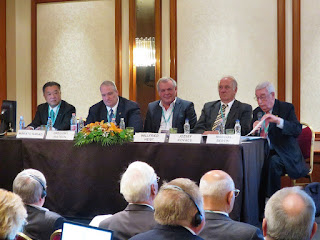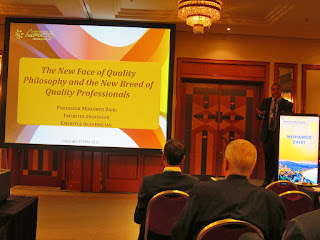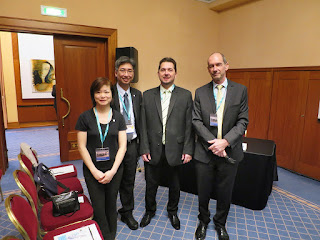Then we met many quality professionals and took a photo for memory below.
I took a photo with Mr. Narayanan Ramanathan (Adviser – TQM, SRL Limited; ISQ).
Minda and I took a photo with Mr. Simon Feary (Chief Executive, CQI).
I met Mr. Anil Sachdev (President, TQM International India) again after ICQ 2014.
We also met our Croatia friends Mr. Sinisa Prugovecki (GM, Head of Lab, Metroteka) and Ms. Lidija Sarta (Head of training and quality development, Metroteka).
I took a photo with ASQ friend from South Africa Mr. Paul Harding (Managing Director, The South African Quality Institute (SAQI).
Then I received Prof. Hiroshi Osada (Professor in Bunkyo University, and Professor Emeritus of Tokyo Institute of Technology) book named “Excellence Business Model” which translated in Chinese.
In the beginning of the forum, Mr. Janak Mehta (Chair of IAQ) gave an opening speech and welcome all participants. He also introduced IAQ that “A community of the world’s leading executives, practitioners and academics dedicated to promoting the cause of quality.”
IAQ had founded since 1966 by Mr. Val A. Feigenbaum, Mr. Kaoru Ishiskawa and Mr. Walter Masing. Mr. Mehta mentioned the IAQ Way – Quality for Humanity, which respect for individual, integrity in thought and action and compassion for all living beings.
Finally, Mr. Janak Mehta discussed the model of “Century of Quality?” and “Whither Quality?”
Prof. Pal Molnar (President of IAQ; President and CEO of Hungarian National Committee for EOQ) gave a speech named “In Remembrance of the IAQ Founders: Armand Val Feigenbaum, Kaoru Ishikawa and Walter Masing”.
Prof. Noriaki Kano gave a presentation “Dr. Kaoru Ishikawa Birth Centenary Commenoration”. Firsty, Prof. Kano asked us three questions about Prof. Kaoru Ishikawa (which originated by Can Y. Ando and modified by N. Kano). (I would share 3 questions below but not release the answers.)
Q1. How do you know Prof. Kaoru Ishikawa?d
a) Father of TPS, b) Father of TPM, and c) Father of QC Circles
Q2. Which country Prof. Ishikawa visited the most?
a) U.S., b) Switzerland, and c) Taiwan
Q3. What Prof. Kaoru Ishikawa used to advise his students?
a) Be Proficient in English, b) Learn to hold you drink, and c) Be good with data.
(If you would like to know the answer, you must attend Prof. Kano’s talk in different quality conferences.)
Then Prof. Kano introduced achievements of Prof. Ishikawa included pioneer to promote TQM in Japanese Way, invention of the Cause & Effect Diagram, founder of IAQ & ICQ. He published 31 books and 647 articles. Prof. Kano shared his memorable photo with Ishikawa which was taken in 1982.
After that Prof. Kano shared his research on Quality for Sales (QfS) and Quality for Cost (QfC). He briefed the Hierarchical Sales Structure Model (HSS Model) and separated Quality into Q1 (Past), Q2 (Present) and Q3 (Future). For Q1 (Past Quality), it further separated into Q1a, Q1b and Q1c below.
Q1a: The customer’s perception of treatment for the warranty claims including recall.
Q1b: The customer’s perception of treatment for paid services including repair after warranty period, periodic maintenance, etc.
Q1c: The customer perception in terms of likes and dislikes.
During the talk, we also fill the questionnaire designed by Prof. Kano. He said either Q1a or Q3 fall under both of QfC and QfS while either Q1b, Q1c, or Q2 falls only under QfS. Finally, he told us the ultimate objective of the Theory of Q1, Q2 and Q3 to apply for marketing and sales in a manufacturing company and then expanded to servicing, housing and so on.
During the Coffee Break, we met different quality professionals and took photos for memory.
Photo with Shan Rupral JM (President, APQO and National Chairman, Australian Organization for Quality (AOQ))
I presented HKSQ annual book and HKSTP souvenir to Prof. Pal Molnar (President of IAQ).
I met Mr. Glenn Mazur (QFD Red Belt, QFD Institute; Japan Business Consultants, Ltd.)
Then we met representative of Shanghai Association for Quality (SAQ) and took a photo for memory.
(Left: Ms. Zhou Xiuhui (Sr. Engineer & Deputy Director, On-Site Service Dept, SAQ), Dr. KS Chin (Asso. Professor, SEEM Dept., CityU & Former Chairman of HKSQ), Ms. Tang Xiaofen (SAQ), Prof. He Zhen (Vice Dean, College of Management and Economics, Tianjin University) and Prof. Deng Ji (Research Associate, Shanghai Academy of Quality Management))
Hong Kong team took a photo in the venue before the next session.
After the break, it was the executive IAQ Panel “Quality and Corporate Management”
Mr. Marcos Bertin was the panel chair (Right) and he said Quality in Governance was about the quality of the governance processes and not only about compliance with regulations.
The 1st panel speaker was Mr. Makato Nakao (President & CEO of GC International AG, Switzerland; Chairman of GC Corporation, Japan) and his presentation entitled “Promotion of GQM and Increasingly Important Roles of Top Management in the Global Perspective”. Firstly, Mr. Nakao introduced his business and product line. Their distribution system (Flow of GC Products) was from GC to their partner “Dealer” and to the customer “Dental Office, dental Laboratory” and finally to the end-user “Patients”.
Then Mr. Makato Nakao shared their management principles from the Three Founders below.
1. Develop a product needed in people’s lives.
2. Develop a product which requires advanced technologies.
3. Develop a high value-added product.
And their corporate philosophy named “SEMUI” that “True products are made for the good of others, not for your own sake. In other words, they co-exist for mutual benefits.”
His grandfather vision was “Love for dentistry” and Prof. Muramatsu suggested “Focus on Genba (Frontline, Site). After that he followed Mr. James C. Abegglen that “Pursue your own way.”
At the end, Mr. Nakao shared his view on the roles of top management included “Corresponding to new changes” (Charles Darwin), “Realize the VISION, in other words, it is to create the future by themselves” (Peter F. Druker), etc. So Mr. Nakao mainly concern “Cope with Changes” that capability to think and determine and capability to take an action.
Then Prof. Kano introduced achievements of Prof. Ishikawa included pioneer to promote TQM in Japanese Way, invention of the Cause & Effect Diagram, founder of IAQ & ICQ. He published 31 books and 647 articles. Prof. Kano shared his memorable photo with Ishikawa which was taken in 1982.
After that Prof. Kano shared his research on Quality for Sales (QfS) and Quality for Cost (QfC). He briefed the Hierarchical Sales Structure Model (HSS Model) and separated Quality into Q1 (Past), Q2 (Present) and Q3 (Future). For Q1 (Past Quality), it further separated into Q1a, Q1b and Q1c below.
Q1a: The customer’s perception of treatment for the warranty claims including recall.
Q1b: The customer’s perception of treatment for paid services including repair after warranty period, periodic maintenance, etc.
Q1c: The customer perception in terms of likes and dislikes.
During the talk, we also fill the questionnaire designed by Prof. Kano. He said either Q1a or Q3 fall under both of QfC and QfS while either Q1b, Q1c, or Q2 falls only under QfS. Finally, he told us the ultimate objective of the Theory of Q1, Q2 and Q3 to apply for marketing and sales in a manufacturing company and then expanded to servicing, housing and so on.
During the Coffee Break, we met different quality professionals and took photos for memory.
Photo with Shan Rupral JM (President, APQO and National Chairman, Australian Organization for Quality (AOQ))
I presented HKSQ annual book and HKSTP souvenir to Prof. Pal Molnar (President of IAQ).
I met Mr. Glenn Mazur (QFD Red Belt, QFD Institute; Japan Business Consultants, Ltd.)
Then we met representative of Shanghai Association for Quality (SAQ) and took a photo for memory.
(Left: Ms. Zhou Xiuhui (Sr. Engineer & Deputy Director, On-Site Service Dept, SAQ), Dr. KS Chin (Asso. Professor, SEEM Dept., CityU & Former Chairman of HKSQ), Ms. Tang Xiaofen (SAQ), Prof. He Zhen (Vice Dean, College of Management and Economics, Tianjin University) and Prof. Deng Ji (Research Associate, Shanghai Academy of Quality Management))
Hong Kong team took a photo in the venue before the next session.
After the break, it was the executive IAQ Panel “Quality and Corporate Management”
Mr. Marcos Bertin was the panel chair (Right) and he said Quality in Governance was about the quality of the governance processes and not only about compliance with regulations.
The 1st panel speaker was Mr. Makato Nakao (President & CEO of GC International AG, Switzerland; Chairman of GC Corporation, Japan) and his presentation entitled “Promotion of GQM and Increasingly Important Roles of Top Management in the Global Perspective”. Firstly, Mr. Nakao introduced his business and product line. Their distribution system (Flow of GC Products) was from GC to their partner “Dealer” and to the customer “Dental Office, dental Laboratory” and finally to the end-user “Patients”.
Then Mr. Makato Nakao shared their management principles from the Three Founders below.
1. Develop a product needed in people’s lives.
2. Develop a product which requires advanced technologies.
3. Develop a high value-added product.
And their corporate philosophy named “SEMUI” that “True products are made for the good of others, not for your own sake. In other words, they co-exist for mutual benefits.”
His grandfather vision was “Love for dentistry” and Prof. Muramatsu suggested “Focus on Genba (Frontline, Site). After that he followed Mr. James C. Abegglen that “Pursue your own way.”
At the end, Mr. Nakao shared his view on the roles of top management included “Corresponding to new changes” (Charles Darwin), “Realize the VISION, in other words, it is to create the future by themselves” (Peter F. Druker), etc. So Mr. Nakao mainly concern “Cope with Changes” that capability to think and determine and capability to take an action.
The 2nd panel speaker was Mr. Willfried Heist (Vice President, Quality and Product Safety KB Group, Germany) and his topic named “Excellence and Values – Way to EFQM Prize and Zero Defect”. He firstly reviewed the 110 years’ experience with braking technology.
Then he briefed their business excellence development and the role of governance since 1997.
After that he shared the KB Competency Model from managing Business to managing People and then to managing Self. The comprehensive model was introduced and discussed.
The last speaker in IAQ Panel was Mr. Greg Watson (Past President of International Academy for Quality (IAQ)) and his topic was “The Price of Non-Policy”. Mr. Watson told us that society paid a “hidden” price for execution of poor business policy. The price of non-policy is not choosing to do better things with the resources of a firm. It represents an irretrievable loss of its financial leverage to create success in the future.
Then Mr. Watson shared the view that Quality as a Social Contract. He separated Board and Management with different roles. Moreover, he mentioned the transformation of an event into data and information from scientifically-based inquiry. He said we must engineer business as an integrated system.
During Open Discussion, Prof. Kano gave some comments
The parallel session in afternoon, I attended the IAQ Panel “Future of Quality Profession” in Stream A. The first speaker was Prof. Mohamed Zairi (Emeritus Professor & Academician) and his topic named “The New Face of Quality Philosophy and the New Breed of Quality Professionals”. He said “the world of ‘Little Q’ no longer exists”.
Prof. Zairi shared some observations including “The Power of Individualization”, “Running Businesses through Internet Technology”. “The importance of Intangible Assets” etc. Then he mentioned business model innovation in different forms.
After that he stated “Personalization is the “Standard”, not the Exception” indicating that one size did NOT fit all (Me Too → For Me Only → My Own). In addition, Value Innovation was discussed that the nature of value is changing, involving new ways to price goods, Innovation and Emotion since new rapidly changing economy. The final model proposed was shown in the following diagram.
The second speaker was Prof. Hiroshi Osada (Professor, Bunkyo University) and his topic entitled “From Quality Manager to Quality Innovator – New role of Quality Profession”. In the beginning, Prof. Osada briefed the change of Quality Management and Quality Professor from QC (1950s-1960s), TQC (1970s-1980s) to TQM (1990s-now).
Prof. Osada classified type of Innovation into 1) Product / Service, 2) Value Chain, 3) Business Model, and 4) System – Institution, Business / Management System; he also classified using value creation as Q (Quality), C (Cost), D1 (Quantity), D2 (Cycle time), S (Safety), and E (Environment) that were output elements of TQM and he said Innovation by Quality Management. Then he briefed New Quality Profession as Change Leader below:
- Quality Manager is to rotate management cycle (PDCA) and promote improvement for sustaining management quality.
- Quality Innovator is change leader through finding innovation bud, breeding it, making output/outcome for stakeholders and rotating constant innovation cycle by TQM approach.
At the end, Prof. Osada introduced his New TQM Model and concluded that New Quality Profession should be Quality Innovator.
The third speaker was Mr. Joseph A. De Feo (On Behalf of Charles Aubrey, USA; Juran Global) and his topic was “The Chief Quality Officer & Effective Leadership”. Mr. Joseph A. De Feo briefed the recruitment requirement of quality profession and identified the maturing and changing role from Production Focus to Process Focus and finally to Enterprise Focus.
Joseph mentioned the future quality officer looked like Integrator, Auditor, Architect and speck the languages of MONEY and RISK. Moreover, Joseph suggested the checklist for Quality Professionals below:
- Recognize that businesses may need new skills
- Emphasize collaboration and engagement
- Do not be locked into a guru or method
- The language of business
- Be multi-lingual in Lean, Six Sigma, QC/QA, Agile, etc.
- Be passionate about what you do & how you do it
- Resumes should reflect your skills and competencies (not just your positions)
In afternoon session, my presentation was in the session named “Quality Management Development”. We meet Mr. Simon Feary (Chief Executive, CQI) and take a photo together.
(Left: Ms. Minda Chiang (HKSQ), I, Mr. Lajos Kovacs (CFU Manager, R&D, Customer Focus Unit , EGIS PLC) and Mr. Simon Feary)
Mr. Simon Feary (Chief Executive, CQI) was the first speaker in this session and his topic entitled “Repositioning Quality – Challenging the profession”. His presentation included three parts and they were “The problem”, “What good looks like” and “How we get there”. The problem he defined was the profession hadn’t made it clear that “Who we are (our definition)?” “What we do (our scope)” and “What we contribute (our value)”.
He mentioned a world where Quality had been an accepted, universal definition and recognized as a ‘proper’ profession, a career option when graduated, etc. However, the Quality’s key deliverable was “Maintaining / Protecting the Organization’s Reputation”. The definition and a framework for competency in CQI were discussed.
The second speaker was Mr. David Hutchins (Principal David Hutchins International Quality College, Visiting Fellow Kingston University) and his presentation named “Quality Mastery by Workplace Agreement”. He aimed to provide state of the art skills based education and training for the next generation of leaders in the Quality Profession.
Then Mr. David Hutchins introduced their Master Course (CQI Level 7) which matching the medium to large organization quality positions requirement. Where Master included 60 credits after Diploma (60 credits) and Certification (60 credits).
Dr. KS Chin (Asso. Professor, MEEM Dept., CityU and Former Chairman, HKSQ) presented his topic named “Qualty and Innovation: a Partner or a Substitute? Management System vs Innovation” in another session (IAQ Panel: Quality and Innovation). Dr. Chin introduced different Innovation types included Organizational, Management, Product, Process, Production, Marketing and Service, etc. He said Quality was the basis of innovation and also guides for technological innovation decisions. Partnering relationship did exist between quality and innovation.
Then Dr. KS Chin shared two cases about Quality and Innovation application in companies. Case 1 is Organizational Innovation Management Model in HK/China; and Case 2 is my case in HKSTP using Integration of Quality and Innovation Management System.
I was the next speaker and my topic entitled “Quality Startup Management System”. There were three parties involved into this project and there were Incubation Program of Hong Kong Science and Technology Parks Corporation (HKSTP), Hong Kong Quality Assurance Agency (HKQAA) and Hong Kong Society for Quality (HKSQ).
Then I introduced all parties and their role and responsibility in the HKQAA – HKSTP Quality Startup Recognition Scheme. HKQAA is a certification body to ensure Startup achieved their specific quality management requirement so as to enhance startup reputation for enterprises. HKSTP is a gatekeeper using regularly milestone assessment to monitor Startup Product Development and Business Development. HKSQ provides theoretical support that suggested the Quality Startup Management System.
After that I reviewed Business Model Canvas (BMC), ISO 9001, HKSTP Incubation Milestone Assessment and HKQAA Quality Startup Checklist and discussed their limitation for startup.
Finally, I proposed the model of Quality Startup Management based on BMC 8 elements under forth sessions (i.e. Customer, Products, Environment and Finance) and three key areas of Milestone assessment and HKQAA three key areas (QC, InfoSec Control & Financial Control) as well as, under PDCA circle.
The last speaker was Mr. Lajos Kovacs (CFU Manager, R&D, Customer Focus Unit , EGIS PLC) and his presentation topic was “Computer System Verification and Validation in the Pharmaceutical Industry”. Firstly, he briefed the purpose of the GxP quality guidelines and some key aspects included Safety, Quality, Security, Reliability and Integrity, Traceability and Transparency, as well as, Risks.
Then Mr. Kovaces mentioned the Computerized System Life Cycle which also interpreted using PDCA from conception to project to operation & Changes and to Retirement. Risk management was in each phase. Finally, he showed the GxP system risk assessment result for discussion.
Reference:
IAQ World Quality Forum - http://www.iaq2015.com
HKSQ - http://www.hksq.org/index.asp

















































沒有留言:
發佈留言